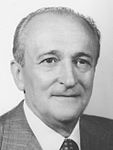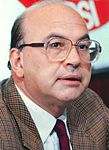1987 Italian Senate election in Lombardy
| |||||||||||||||||||||||||||||||||||||
All 48 Lombard seats to the Italian Senate | |||||||||||||||||||||||||||||||||||||
|---|---|---|---|---|---|---|---|---|---|---|---|---|---|---|---|---|---|---|---|---|---|---|---|---|---|---|---|---|---|---|---|---|---|---|---|---|---|
| |||||||||||||||||||||||||||||||||||||
| |||||||||||||||||||||||||||||||||||||
Lombardy elected its tenth delegation to the Italian Senate on June 14, 1987. This election was a part of national Italian general election of 1987 even if, according to the Italian Constitution, every senatorial challenge in each Region is a single and independent race.
The election was won by the centrist Christian Democracy, as it happened at national level. Seven Lombard provinces gave a majority or at least a plurality to the winning party, while the agricultural Province of Pavia and Province of Mantua preferred the Italian Communist Party.
Background[]
Bettino Craxi's Italian Socialist Party reduced its gap with the Italian Communist Party after Enrico Berlinguer's death. Many minor parties obtained a seat: between them, for the first time, Umberto Bossi's Lega Lombarda (Lega Nord since 1991).
Electoral system[]
The electoral system for the Senate was a strange hybrid which established a form of proportional representation into FPTP-like constituencies. A candidate needed a landslide victory of more than 65% of votes to obtain a direct mandate. All constituencies where this result was not reached entered into an at-large calculation based upon the D'Hondt method to distribute the seats between the parties, and candidates with the best percentages of suffrages inside their party list were elected.
Results[]
| Party | votes | votes (%) | seats | swing |
|---|---|---|---|---|
| Christian Democracy | 1,845,626 | 34.4 | 18 | |
| Italian Communist Party | 1,319,356 | 24.6 | 12 | |
| Italian Socialist Party | 901,296 | 16.8 | 8 | |
| Italian Social Movement | 249,470 | 4.7 | 2 | = |
| Italian Republican Party | 217,157 | 4.1 | 2 | |
| Federation of Green Lists | 139,573 | 2.6 | 1 | |
| Lega Lombarda | 137,276 | 2.6 | 1 | |
| Radical Party | 133,181 | 2.5 | 1 | = |
| Italian Democratic Socialist Party | 127,828 | 2.4 | 1 | |
| Italian Liberal Party | 124,418 | 2.3 | 1 | |
| Proletarian Democracy | 108,990 | 2.0 | 1 | |
| Others | 56,617 | 1.1 | - | = |
| Total parties | 5,360,788 | 100.0 | 48 | = |
Sources: Italian Ministry of the Interior
Constituencies[]
- No senator obtained a direct mandate. Please remember that the electoral system was, in the other cases, a form of proportional representation and not a FPTP race: so candidates winning with a simple plurality could have (and usually had) a candidate (usually a Christian democrat) with more votes in their constituency.
Substitutions[]
- for Monza (32.8%) replaced in 1988. Reason: death.
- for Monza (25.1%) replaced Antonio Taramelli in 1989. Reason: death.
- for Varese (31.0%) replaced in 1991. Reason: death.
- for Varese (17.9%) replaced Antonio Natali in 1991. Reason: death.
- for Milan 3 (17.4%) replaced in 1991. Reason: resignation.
- Pietro Fiocchi for Lecco 3 (5.9%) replaced Giovanni Malagodi in 1991. Reason: death.
- for Pavia (30.8%) replaced in 1992. Reason: resignation.
Notes[]
- ^ Incumbent MP Mario Capanna helped his party running for this seat. However, according to the Italian Constitution, MPs can't be senators, so he ceded his senatorial seat to his party-mate .
- Elections in Lombardy
- 1987 elections in Italy


